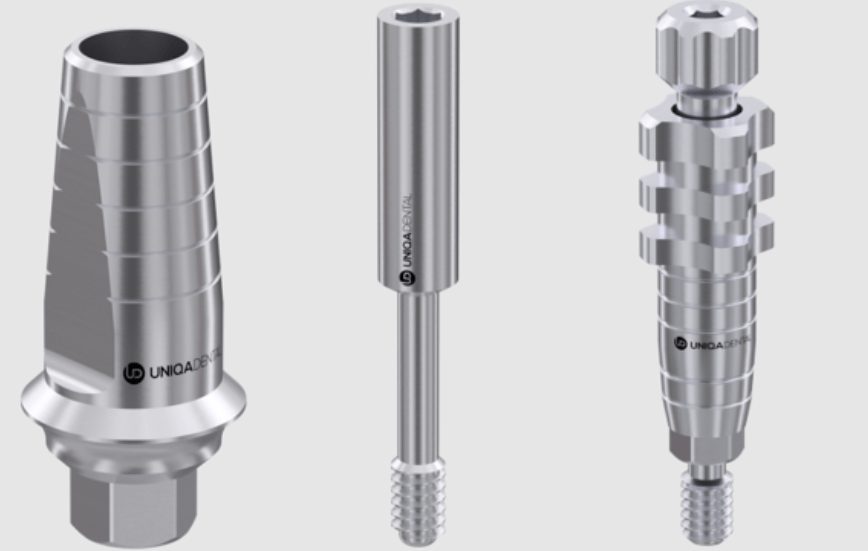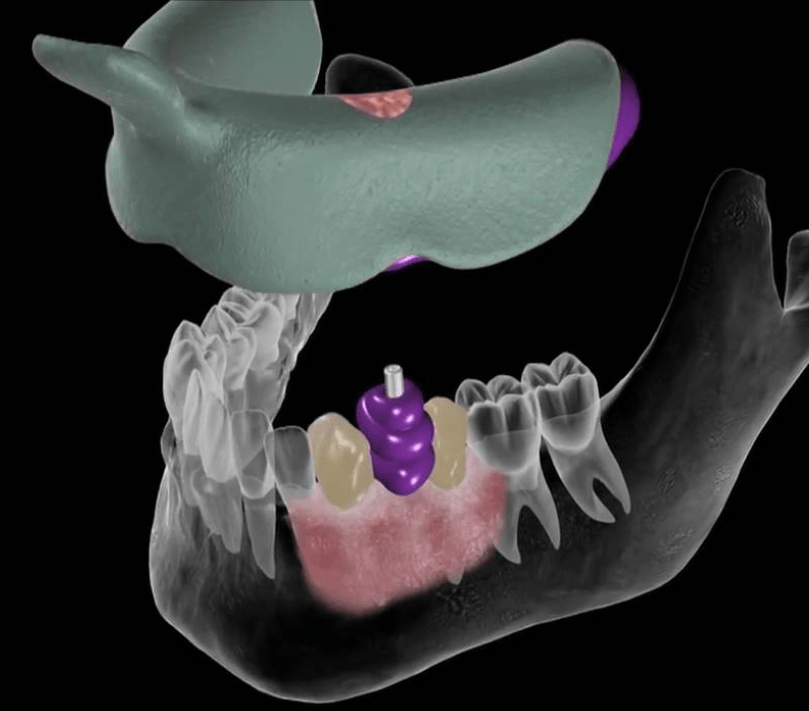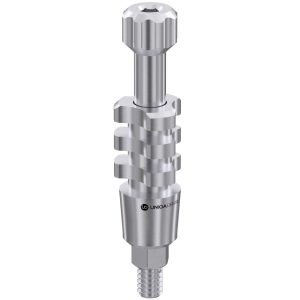In this section, you can buy transfers for taking an impression of the patient’s jaw. As well as all the accessories need, for example, screws, plugs, etc. Before making a decision, let’s recall the procedure for taking an impression and the factors that should be considered when choosing.

Why are impression transfers needed?
Transfers are needed to copy the exact location of the implant when creating a jaw model. First, the transfer is attached to the implant in the patient’s mouth. A small amount of self-hardening agent is applied to it. Then a special tray (spoon) completely filled with the same plastic mass is placed in the patient’s oral cavity. After hardening, the spoon is removed and the hardened mass provides the dentist with an impression of the exact location of the teeth and soft tissues. The transfer also leaves an impression that gives the exact location of the implant.
The second stage of creating a model of the jaw is that a special plaster is poured into the resulting cast, which does not change its size when it hardens. Before pouring the plaster, a laboratory analogue of the implant is attached to the transfer that remains in the cast. After receiving the model, the implant analog accurately repeats the anatomical position of the real implant in the patient’s mouth. On the received jaw model, the dental technician models and adjusts the crown or multiple restoration so that a perfectly fitting prosthesis can be installed in the patient’s mouth.
It is recommended to buy several types of transfers and two technologies for taking an impression with a closed and open tray. Uniqa Dental produces transfers for both technologies. Each of the options has its own advantages and disadvantages. Let’s analyze this. In both cases, the transfers are screwed into an already healed dental implant. Here is a short algorithm of actions:
- Remove the healing cap (gingiva former).
- Set transfer. If this is a transfer for a closed tray, then you need to close the screw shaft with a special cover (cap) because the transfer with a cap will be completely filled with polyester or silicone mass. If an open tray transfer is used, caps are not needed.
- Take an x-ray to make sure that the transfer interface is properly seated in the dental implant.
- Place the tray with the plastic mass in the patient’s oral cavity and wait for the material to polymerize. The illustration below shows the option of taking an impression with an open tray. In this case, the transfer has a long screw that goes through the hole beyond the spoon. After hardening, the screw is unscrewed and the spoon, together with the impression and the transfer in it, is removed from the patient’s mouth.

If a closed spoon was used, then a short transfer is used that does not go beyond the spoon. At the same time, the screw is hidden in the transfer shaft, and the shaft itself is closed with a cap so that the plastic mass does not get inside. After removing the spoon, the transfer remains in the patient’s mouth, and the cap remains in the impression, which serves as a seat for the transfer in subsequent procedures.
- Remove the impression tray from the patient’s mouth. If the operation was performed with a closed tray, then the transfers remain attached to the dental implant and must also be removed. Implant analogs are attached to the removed transfers and in this form they are inserted into the impression where cavities are formed under the transfers. The caps securely hold the transfer so that it does not move when pouring the plaster. If the impression was formed using the open tray technology, then before removing the tray, you need to unscrew the screws holding the transfer in the patient’s jaw. After that, the spoon with the cast is removed from the mouth. The transfers remain in the cast. Laboratory analogues of implants should now be attached to them and poured with plaster to obtain a working model of the jaw for the dental technician. The finished model of the jaw is checked for defects and inaccuracies. If any are found, then the procedure is repeated. At the end of both methods, the gingiva formers are installed.
After the procedures described above, the dental technician has at his disposal a jaw model with implant analogues installed in it, which can also be purchased through this site, on which you can model a denture of any complexity. See the picture below.

The open tray technique, when the copings are not removed from the impression, is less accurate. Long screws that extend beyond the tray make it difficult to work in the molar area. The patient’s mouth simply cannot open wide enough to accommodate a long transfer. Therefore, it is necessary to buy transfers of all varieties.
Most often, the impression of the jaw is taken from the level of implants, but can also be taken from the level of the abutment. The complexity of the second option is such that it is much easier to find the ideal position for the abutment on the model than in the patient’s oral cavity.
The procedure for taking an impression is unpleasant for the patient and requires a lot of time and effort from the dentist. Therefore, digital CAD /CAM technologies are increasingly being used, where the jaw model is obtained as a 3D file. For which scan markers are attached to dental implants and the oral cavity is scanned with an intraoral scanner. The procedure takes a few minutes and the patient can be released. There are then two ways:
If necessary, a 3D model of the jaw is printed, in which implant analogs or implant analogs with an abutment can also be installed in the form of a single piece working with the printed model in the same way as with the cast model.
Based on the 3D model of the jaw, a digital model of the crown or bridge structure is created and machined on a CNC machine. A crown or bridge restoration can be either permanent or temporary. Temporary dental prostheses are made of durable polymers, and are most often used if an immediate restoration of the aesthetic zone was carried out. Polymer restoration of the dentition is much lighter than the permanent one and this makes it possible to reduce the load on the implants. This is essential for successful osseointegration. Also, a temporary crown or bridge can be partially removed from the occlusion to reduce the load until the dental implants are fully integrated.
What types of transfers can be bought on the Uniqa Dental website?
Transfers that can be bought on the Uniqa Dental website are reusable; they are made of Grade 23 – an alloy of titanium with vanadium and aluminum. Other manufacturers often make stainless steel impression transfers. Titanium transfers are much stronger and more resistant to wear. At the same time, the price of transfers from Uniqa Dental is not much higher, and they will pay off given the long service life.
Transfers, like implant analogues, must have the same implant/abutment connection interface. Transfers from Uniqa Dental are compatible with most popular brands that are used in the United States, see the table below.
| Hexagonal inner connection |
Connection cone 22° |
| Zimmer |
Hiossen/Osstem |
| MIS |
Nobel Biocare |
| Alpha Bio |
Magagen Any Ridge |
| Cortex |
Megagen Any One |
| Adin |
|
Why it is profitable to buy laboratory transfers from Uniqa Dental
Confidence in the quality of products is the main criterion for ordering. If you choose Uniqa Dental, it is useful to know that the lion’s share of resources is directed to the development and improvement of technologies whereas many other manufacturers spend a significant part of their budget on marketing and promotional materials. In any case, the price of a quality part, no matter whether it is the transfer or a laboratory screw, is negligible against the background of the cost of the entire course of treatment. However, the problems associated with the deformation of the transfer will be very expensive.
Dentists choose to work with Uniqa Dental because:
- Our clients only pay for quality. The company invests a minimum in marketing and advertising. Our main efforts are invested in equipment and technologies, which allows us to successfully compete with the best samples. The cost of transfers from Uniqa Dental does not include marketing costs, which do not affect the quality of products. Clients buy only the transfer itself and this is the best you can find for this money.
- You can buy from one unit of any product, which means there are no mandatory purchases for a certain amount. There is no need to freeze money by investing in implants and accessories, and we will deliver your order absolutely free of charge anywhere in the world.
- In addition, we have a warehouse in the United States, so the order will be delivered as soon as possible.
If you would like to receive samples for testing, please send a request and we will contact you as soon as possible.











